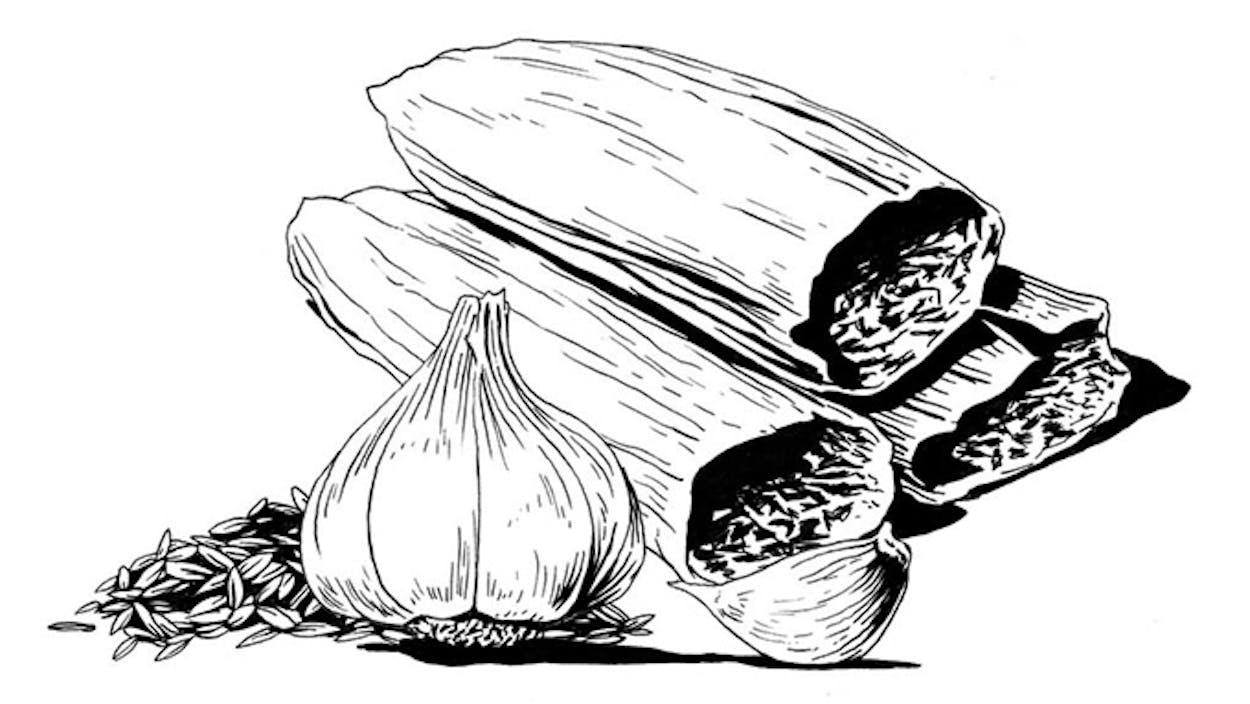The first year I threw my own tamalada, I sought my mother’s advice beforehand. “Tamaladas are fun,” she said, “but not for the host.” I shrugged off her warning. When I was growing up, my mom and her six siblings gathered every winter to make tamales, rotating hosting duties from year to year. I remember having to clean my room and help my mom prep food before the thirty or so aunts, uncles, and cousins filled the house. But mostly my memories are of the warm smell of cumin and laughing so hard my cheeks hurt the next day. What’s a little work when the payoff is so good?
I promptly invited twenty people to my house—none of whom, I should note, had ever been to a tamalada. I fired off an email telling them to bring fillings and that I’d “take care of the rest.” The day before the party, I headed to Fiesta for everything we’d need: fresh garlic, a tub of cumin, a bag of onions, tens of pounds of lard and masa, fatty pork butts for more filling, plus ingredients to make homemade tortillas, borracho beans, and Spanish rice. Oh, and Ziploc bags for the finished tamales. And trash bags. And paper towels. And beer. And ice. And did I have enough spoons, knives, and spatulas to spread masa with? And—suddenly, as I stood in the grocery aisle, my mind flashed back to my aunts and uncles, gathered around piles of receipts and a calculator as they divvied up costs and tamales by family. This was not the cheapest of endeavors.
I got home and began frantically trimming corn husks. I boiled, shredded, and seasoned the pork. I washed out coolers. I cleaned the bathroom and mopped my floors. I set up a rented table and chairs. I finally fell into bed at three in the morning, only to rise a few hours later to play hostess (“¡Bienvenidos, mis tamaleros! Beer goes in the cooler!”), trainer (“No, no, spread the masa on the smooth side of the hoja”), and manager to a group whose focus waned as the number of empty beer cans grew (“Please put that down. The filling is for stuffing the tamales, not your face”). Was I having fun? I wasn’t sure.
But when we tallied up our bounty at day’s end, we’d made nearly one thousand tamales—a right good haul for a bunch of newbies. And they tasted almost as good as the ones I ate as a kid. Best of all, coming together as a group of people who loved one another reminded me of my family—so much so that I’ve hosted a tamalada every year since. I love how my house smells like warm cumin and I laugh so hard my cheeks hurt the next day.
The chile paste:
20 to 25 ancho chiles, seeds and stems removed
hot water for soaking
Soak chiles in water until soft. In a food processor, grind chiles into a thick paste, adding the soaking water as needed. (To make tamales spicy, also prepare 10 to 12 árbol chiles in the same way.) Set aside to use in filling and masa.
The pork filling:
1 four-to-five-pound bone-in pork butt
1 large onion, quartered
8 garlic cloves, 4 whole and 4 minced
2 teaspoons salt
1 teaspoon pepper
8 tablespoons lard
2 to 4 tablespoons ground cumin
2/3 cup chile paste
salt and pepper to taste
Cover the pork with water in a deep, heavy pot and boil with onion, whole garlic cloves, salt,and pepper for 90 minutes, or until the meat’s internal temperature reaches 160 degrees. Reserve at least 2 cups of pork stock. Remove the pork, allow to cool, then shred the meat, discarding bone and excess fat. Melt the lard in a large cast-iron skillet over medium heat. Add 2 tablespoons cumin, minced garlic, and 1/2 cup chile paste and sauté for 3 to 4 minutes, until fragrant. Add shredded meat and enough stock to moisten the mixture. Add remaining chile paste, cumin, salt, and pepper to taste (use árbol paste here if you want heat). Set aside. Filling may be prepared a day ahead.
The masa:
1 ten-pound bag fresh masa (available at Fiesta supermarkets)
2 1/4 pounds lard
1/4 to 1/3 cup pork stock, warm
2 tablespoons salt, or to taste
1/3 cup chile paste, or to taste
On a large work space, knead the lard into the fresh masa for 10 to 15 minutes, adding pork stock a little at a time until the masa is cohesive.
Add salt and chile paste to taste. You can test the masa’s readiness by dropping a small amount in a glass of water: if it floats, it is ready to spread.
The tamales:
4 to 5 bags dried corn husks (available at Fiesta supermarkets)
Soak husks in warm water overnight. When you’re ready to start, dry off a handful and place within reach. Take a husk and thinly spread 2 or 3 tablespoons of the masa on its smooth side, covering the bottom two thirds of the husk. Down the middle of the masa, place about a tablespoon or so of filling. Now fold one side of the husk over the filling, followed by the other side. Then fold the bottom end of the husk toward the exposed edge. Repeat until all the tamales have been made.
Fill steamer pot with water to bottom of basket and bring to a boil. Fill basket with tamales, placed vertically with open end up. Secure lid and steam until masa is firm, about 90 minutes. Makes about ten dozen tamales.
- More About:
- Texas History
- Tamales







